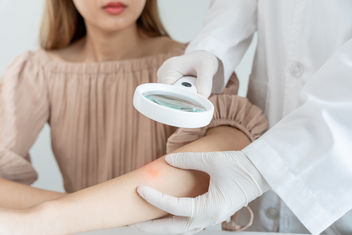Common Skin Disorders: Treatment Overview
November 10, 2022Skin disorders impact millions of people, and can come in many different forms. The severity of skin conditions varies per person, per condition. While there are so many different types of skin conditions, there are also a number treatment options available to help. Read on to learn more about treatment options for more common skin disorders.

The Inside Rx Blog
Get the Inside Scoop on tips & tricks that may help your family save on prescriptions!
Subscribe to stay up to date with the latest news and tips
Reviewed by the Office of Clinical Evaluation and Policy (OCEP), Evernorth
There are numerous skin disorders that can have various causes. Some skin disorders can be chronic conditions, while others can be temporary. Symptoms of skin disorders can range in severity from minor to severe, with some symptoms going away on their own and other symptoms requiring medical treatment. Common skin conditions include acne, hives, atopic dermatitis (eczema), rosacea, psoriasis, and vitiligo.
Various treatments are available to help manage skin disorders. Depending on the condition being treated, certain treatments may be more appropriate than others. Treatments are available in different preparations, including ointments, creams, lotions, solutions and oral tablets or capsules.
Continue reading for an overview of the most common drug classes used to treat skin disorders.
Corticosteroids
Corticosteroids are a common class of drugs used to relieve inflammation on the skin. In reducing inflammation, corticosteroids can help treat itching, swelling, and redness. Corticosteroids can be useful for treating allergic reactions on the skin and other inflammatory skin disorders, such as eczema. Examples of corticosteroids include hydrocortisone, betamethasone, and triamcinolone.
Antibiotics
Skin disorders caused by bacteria may be treated with oral or topical antibiotics. Treating the underlying infection of a skin disorder can help relieve symptoms. Certain antibiotics can be used to treat certain skin conditions, such as acne, rosacea, and impetigo. Examples of antibiotics include clindamycin, erythromycin, and metronidazole.
Antifungals
Antifungals can help treat fungal infections of the skin, scalp, and nails. For example, antifungals can help treat conditions such as athlete’s foot and ringworm. In some cases, antifungals may be combined with other topical medications, such as corticosteroids. Examples of antifungals include ketoconazole, terbinafine, and miconazole.
Antivirals
Antivirals are medications used to treat skin disorders caused by viruses, such as shingles and herpes. They may be applied topically or taken orally to treat viral infections. Examples of antiviral drugs include acyclovir, valacyclovir, and famciclovir.
Antihistamines
Antihistamines may be included in topical medications or taken orally to treat allergic skin disorders. Oral antihistamines may be preferred over topical antihistamines to relieve itching due to the possibility of an allergic reaction, which may require immediate medical treatment. Examples of antihistamines include Zonalon® (doxepin) and diphenhydramine.
Non-steroidal medications
Certain medications, including Eucrisa® (crisaborole), tacrolimus, and pimecrolimus can be used to treat inflammation caused by atopic dermatitis (eczema). Because they do not cause skin thinning like corticosteroids, these treatments may be preferred for long-term use.
Salicylic acid
Salicylic acid is a keratolytic agent that helps soften the outer layer of the skin and loosen scales. Salicylic acid may be used to treat acne, ichthyoses, and psoriasis.
Retinoids
Retinoids are common medications used to treat certain skin disorders, such as acne and psoriasis. These medications are derived from vitamin A and work to speed up skin cell turnover. Examples of retinoids include adapalene, tretinoin, and tazarotene.
Benzoyl peroxide
For mild to moderate acne, benzoyl peroxide may be used. It works in several ways, such as removing dead skin cells, removing excess oil, and fighting the bacteria on the skin.
Immunosuppressants
Immunosuppressants are sometimes prescribed to treat moderate to severe cases of eczema and psoriasis. They work by reducing the activity of the immune system to decrease inflammation. Examples of immunosuppressants include methotrexate and cyclosporine.
Biologics
Biologics are relatively new treatments used to treat psoriasis and other skin disorders. These medications can help block certain immune processes that lead to inflammation. Examples of biologics include Remicade® (infliximab), Humira® (adalimumab), and Enbrel® (etanercept).
Pantoprazole Sodium
$ 8.04Escitalopram Oxalate
$ 10.73Other treatments for skin disorders
There may be other treatments other than those listed to help manage skin disorders. Consult a healthcare provider for the best treatment option for you. In addition to medications, healthy skincare habits may be recommended, such as cleansing, protecting, and moisturizing the affected area.
Sources:



